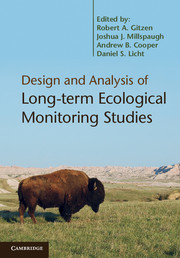Book contents
- Frontmatter
- Contents
- List of contributors
- Foreword: Ecology, management, and monitoring
- Preface
- Acknowledgments
- Abbreviations
- Section I Overview
- Section II Survey design
- Section III Data analysis
- 11 Analysis options for estimating status and trends in long-term monitoring
- 12 Analytical options for estimating ecological thresholds – statistical considerations
- 13 The treatment of missing data in long-term monitoring programs
- 14 Survey analysis in natural resource monitoring programs with a focus on cumulative distribution functions
- 15 Structural equation modeling and the analysis of long-term monitoring data
- Section IV Advanced issues and applications
- Section V Conclusion
- References
- Index
- Plate Section
13 - The treatment of missing data in long-term monitoring programs
Published online by Cambridge University Press: 05 July 2012
- Frontmatter
- Contents
- List of contributors
- Foreword: Ecology, management, and monitoring
- Preface
- Acknowledgments
- Abbreviations
- Section I Overview
- Section II Survey design
- Section III Data analysis
- 11 Analysis options for estimating status and trends in long-term monitoring
- 12 Analytical options for estimating ecological thresholds – statistical considerations
- 13 The treatment of missing data in long-term monitoring programs
- 14 Survey analysis in natural resource monitoring programs with a focus on cumulative distribution functions
- 15 Structural equation modeling and the analysis of long-term monitoring data
- Section IV Advanced issues and applications
- Section V Conclusion
- References
- Index
- Plate Section
Summary
Introduction
Monitoring environmental resources, such as populations of animals and plants and their habitats, is essential for determining their general status (e.g. Likens 1983, Thompson et al. 1998). The objective of a monitoring program typically is to track a target variable over time to detect changes, either with periodic (e.g. annual) measures of an attribute such as population size or with estimates of overall trend during that time. In the case of monitoring focused on animals or plants (e.g. Ralph and Scott 1981, Menges and Gordon 1996, Elzinga et al. 1998), often a fixed set of sites within a species’ range are visited periodically and the number of individuals at each site counted. Our discussion is in terms of counts of animals or plants but applies more generally to other natural resources. The sites may have been chosen on a systematic basis, may have been randomly selected, or may encompass the entirety of the species’ known range. If all sites are monitored on all occasions, analysis of resulting data is relatively straightforward; sampling variability, however, may come into play if only a sample of the possible known locations are monitored on each occasion.
It can happen that not all sites are examined on every scheduled occasion. There are contexts in which missing data are not a critical problem, depending on why data are missing (Chapters 7, 15). In programs such as the North American Breeding Bird Survey, certain results are based on mean counts of sites (routes) within each stratum. Missing counts – routes not surveyed – will reduce the precision of an estimator but not bias it unless a relation exists between the abundance of a species on a route and the probability that the route is not surveyed (e.g. if some routes are less likely to be surveyed because they have too few “interesting” birds to appeal to observers). For the types of monitoring programs that are the focus of this chapter, however, missing data can be problematic.
- Type
- Chapter
- Information
- Design and Analysis of Long-term Ecological Monitoring Studies , pp. 298 - 312Publisher: Cambridge University PressPrint publication year: 2012
- 3
- Cited by

